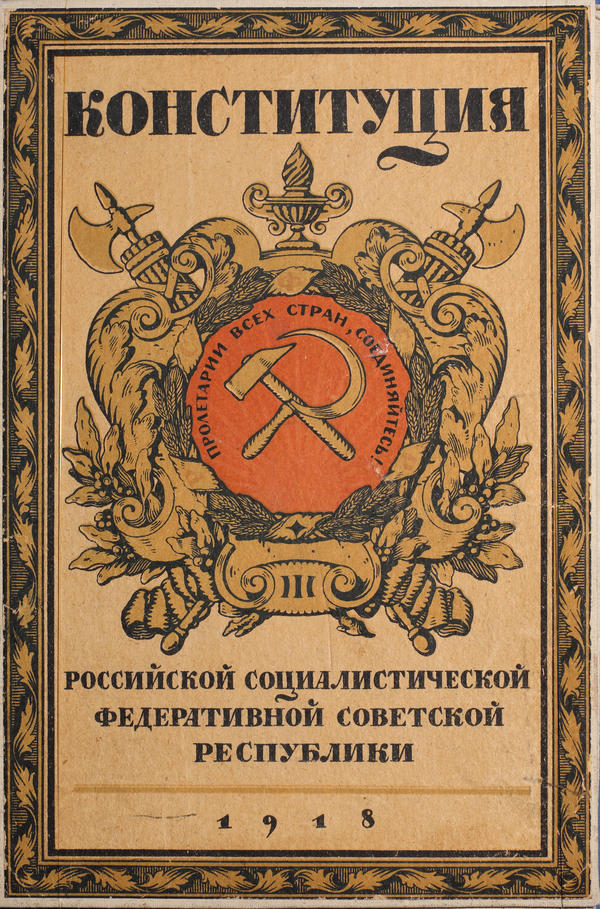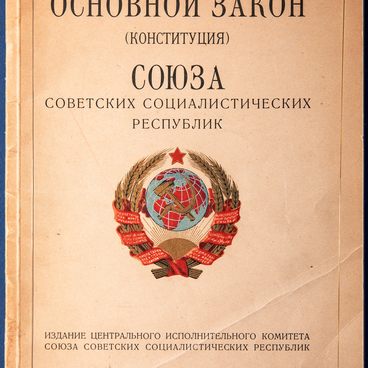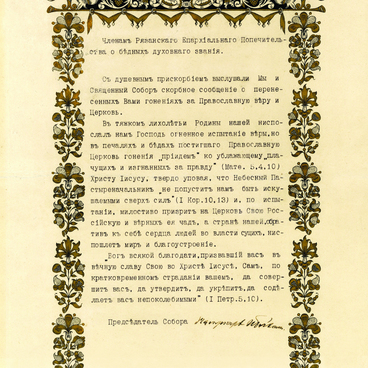After the October revolution of 1917, the Russian Soviet Republic was established. The new state had to shape its own judicial and ideological basis, which is why the issue of the constitution development was raised already at the 3rd All-Russia Congress of deputies from workers, farmers, Red Army servicemen and Cossacks in January, 1918.
The Congress approved of the Declaration of Rights of Working and Exploited People and tasked the Central Executive Committee to elaborate the main provisions of the constitution…to be considered at the next Congress of Soviets. But, due to the aggravation of the political situation, the work over the draft had to be postponed, and, as the 4th All-Russia Congress of Soviets, held in March, 1918, was of an extraordinary character and was related exclusively to the conclusion of the Brest peace accord, the future constitution was not discussed there.
The issue of the fundamental law of the state was raised again at the sessions of the Central Committee of the Russian Communists Party of the Bolsheviks in March, 1918. After a series of discussions, it was recommended that the Central Executive Committee should set up a Constitutional Commission, which emerged just on the next day.
On April 19, the 15-member commission considered three drafts of the constitution, submitted by the Bolsheviks faction, left-wing communists and maximalist socialist-revolutionaries, and approved of the General Provisions of the RSFSR Constitution, developed by the Bolsheviks, as the basis of the future code of laws. They were based in many respects on the Highlights on the Type of Federation document, which was produced with participation of Joseph Stalin and Yakov Sverdlov.
The Provisions were sent for the follow-up revision, and the Ad Hoc Commission of the Central Committee of the Russian Communist Party of the Bolsheviks, headed by Vladimir Lenin himself, was tasked to monitor the process of the development of the final draft of the constitution. On July 3, 1918, it received an additional version of the constitution from the Central Executive Committee, which, inter alia, included several provisions proposed by the People’s Commissariat of Justice. And Lenin insisted that the constitution should incorporate fully the Declaration of Rights of Working and Exploited People too.
At a concluding session of the 5th All-Russia Congress of Soviets, which was held on 10 July, 1918, the delegates approved of the submitted report on the constitution and took the following decision: “The Declaration of Rights of Working and Exploited People, approved of by the 3rd All-Russia Congress of Soviets in January, 1918, and the Constitution of the Soviet Republic, approved of by the 5th All-Russia Congress of Soviets, constitute the Fundamental Law of the Russian Soviet Federated Republic”.
The Congress approved of the Declaration of Rights of Working and Exploited People and tasked the Central Executive Committee to elaborate the main provisions of the constitution…to be considered at the next Congress of Soviets. But, due to the aggravation of the political situation, the work over the draft had to be postponed, and, as the 4th All-Russia Congress of Soviets, held in March, 1918, was of an extraordinary character and was related exclusively to the conclusion of the Brest peace accord, the future constitution was not discussed there.
The issue of the fundamental law of the state was raised again at the sessions of the Central Committee of the Russian Communists Party of the Bolsheviks in March, 1918. After a series of discussions, it was recommended that the Central Executive Committee should set up a Constitutional Commission, which emerged just on the next day.
On April 19, the 15-member commission considered three drafts of the constitution, submitted by the Bolsheviks faction, left-wing communists and maximalist socialist-revolutionaries, and approved of the General Provisions of the RSFSR Constitution, developed by the Bolsheviks, as the basis of the future code of laws. They were based in many respects on the Highlights on the Type of Federation document, which was produced with participation of Joseph Stalin and Yakov Sverdlov.
The Provisions were sent for the follow-up revision, and the Ad Hoc Commission of the Central Committee of the Russian Communist Party of the Bolsheviks, headed by Vladimir Lenin himself, was tasked to monitor the process of the development of the final draft of the constitution. On July 3, 1918, it received an additional version of the constitution from the Central Executive Committee, which, inter alia, included several provisions proposed by the People’s Commissariat of Justice. And Lenin insisted that the constitution should incorporate fully the Declaration of Rights of Working and Exploited People too.
At a concluding session of the 5th All-Russia Congress of Soviets, which was held on 10 July, 1918, the delegates approved of the submitted report on the constitution and took the following decision: “The Declaration of Rights of Working and Exploited People, approved of by the 3rd All-Russia Congress of Soviets in January, 1918, and the Constitution of the Soviet Republic, approved of by the 5th All-Russia Congress of Soviets, constitute the Fundamental Law of the Russian Soviet Federated Republic”.



